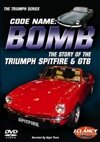Model Page
Triumph Spitfire Mk 1

|
Production Run: |
45,573 |
|---|---|
|
Production Date: |
1962 - 1964 |
|
Engine: |
Triumph 1,147cc Straight 4 |
|
Built: |
Canley (UK) |
|
0-60: |
17.3 secs |
|
Max Speed: |
92 Mph |

Introduced in October 1962 the Triumph Spitfire 4 was a two seat sports car, styled by Michelotti and sharing much of its mechanical components with the Triumph Herald the vehicle was a direct response to the Austin-Healey Sprite that was proving hugely successful. The Spitfire Mk 1 remained in production until 1964 and amassed 45,573 vehicle sales before it was replaced by the revised Spitfire Mk 2.
The Austin-Healey Sprite was announced to the press in May 1958 and proved highly successful for the company in terms of profitability and sales. Following the introduction of the Sprite to the US market, Triumph were inundated with requests from their US dealers to supply a small, low cost two seat, convertible sports car – in short Triumph had to react. Manufacturing and marketing such a vehicle was not unknown to Triumph who were already in the sports car business producing the albeit larger and more expensive TR3 that was proving a huge hit in the U.S. with demand outstripping supply.
Development of the rival to the Sprite took place under the code name “Bomb”, the project was controlled by Harry Webster with styling undertaken by Michelotti. Since early 1957 Triumph had been working on a project codenamed Zobo; the project was intended to develop a line of vehicles based around a new backbone chassis to replace the Standard 10 this vehicle was duly christened as the Herald. Management first toyed with the idea of introducing a small sports car based on the Herald in August 1957 as development of Zobo was entering the styling phase. At this stage the idea was to build a two seat sports car on a shortened Herald platform utilising a tuned version of Triumphs 948cc four cylinder engine.
Michelotti was appointed as the stylist for the vehicle and throughout 1959 and 1960 the design of the vehicle went through a multitude of iterations as Webster and Michelotti refined the design of the vehicle. The styling of the was compromised in some areas due to the vehicle utilising large parts of the Heralds underpinnings; the inner wheel arches and rear floor pans taken directly from the Herald. Webster also wanted the tops of the doors to be as low as possible resulting in the doors having a scooped appearance, pop up headlamps were considered and made it to a production mock up before being rejected. The final result was an attractive swooping streamlined body that gave the Spitfire a unique and unmistakable silhouette.
As project Bomb progressed engineering of the vehicle moved the car to use a chassis unique to the vehicle along with replacing the engine with a twin carburettor equipped 1,147cc four cylinder unit taken that was to be used in the Herald. By 1960 the development team had fixed a number factors including setting the wheelbase to 83” some 8.5” shorter than the Herald platform but more importantly 3” longer than the Sprite; keeping with Triumphs desire of making the car superior to Austin Healey’s competitor. The braking system for the vehicle consisted of Girling sourced 9” front discs and 7” rear drums braking system and a modified version of the suspension and steering setup used in the Herald.
Construction of the prototype vehicle commenced in September 1960 based on a Herald Coupe with a 948cc engine, the test vehicle was driven to the Michelotti styling studios in Turin for the prototypes styling to be completed. It was on the return journey that the driver realised that the engine was simply underpowered for the vehicle resulting in the Triumph moving away from the 948cc unit to a 1,147cc four cylinder engine.
By the start of 1960 Triumph was suffering from a slump in sales and was haemorrhaging money, as a result work on project bomb was shelved and the prototype was stored away in a quiet corner of the design facilities underneath some dust sheets. It was around this time that fellow British company Leyland Motors Company were looking to expand away from its traditional truck and bus manufacturing business into the car market. Leyland Motors completed their take over of Standard Triumph in April 1961 following a successful bid tabled in December 1960 and Stanley Markland was appointed CEO of Triumph.
But for a twist of fate the Spitfire may never have been, whilst walking through the factory with Harry Webster in mid 1961 Markland spotted a hump under a dust sheet and proceeded to enquire what it was. Webster pulled of the dust sheet to reveal the Bomb prototype, impressed by the design Markland asked further questions enquiring as to how far development had progressed. Webster told the CEO that the project had been abandoned due to cash constraints, Stanley took a closer look at the vehicle even sitting in at one point before declaring “That’s good. We’ll make that”.
Development began once more, little changed from the prototype to the final production vehicle the most notable change was the replacement of the full width rear chrome bumper with a two part bumper with over-riders that curved around each corner. In line with making the Spitfire superior to the Sprite the vehicle had a 1,147cc overhead valve four cylinder unit installed that was also seen in the Herald but for use in the Spitfire was slightly tuned and was equipped with twin SU Carburettors to provide additional performance. The engine generated 63 bhp @ 5,750 rpm and 67 lb/ft of torque @ 3,500 rpm a significant improvement on the same unit installed in the Herald.
The suspension and steering systems were carried over from the Herald to a high degree utilising double wishbones with coil springs and telescopic dampers at the front and at the rear single traverse leaf swing axle. It was this rear swing axle that gave rise to some criticism levelled towards the car, an unwanted characteristic of the arrangement was that under hard cornering the rear wheels had a tendency to tuck in causing the car to move from a mild under-steer to a violent over-steer in certain conditions.
Unlike the bolt together Herald body tub, Triumph designed the car to use a single piece steel body-shell, a fibreglass equivalent had been considered but was dropped due to cost constraints. The body was bolted to a highly modified Herald chassis that was unique to the model, the outer rails and rear outriggers having been removed, to stiffen the body tub sufficiently the Spitfire used structural outer sills and had sturdy box section sills under the doors. additionally Triumph used a front hinged bonnet similar to the Herald that provided excellent access to the engine and front suspension.
In contrast to the Austin-Healey Sprite the Spitfire received wind down front windows and a larger passenger compartment, the interior of the vehicle was designed under the direction of Arthur Ballard even so it was not particularly well appointed but was typical of a car in its class at the time including rubber mats and a somewhat basic dashboard that included speedometer, tachometer, fuel and temperature gauge.
The name of the vehicle was set by Sales Director Donald Stokes in 1962, whether or not Vickers were consulted on the use of the name from their famous fighter is unknown although there are rumours that Triumph were given permission to use this name after Vickers had launched a plane named the Vanguard after a Standard Triumph car.
The vehicle was launched at the 1962 London Motor Show and was a resounding success for Triumph, despite being significantly more expensive than its closest rival the Sprite costing £641 against £587 the Spitfire managed to outsell the Austin Healey in every year of manufacture with the exception of a solitary year where labour strikes severely hampered manufacturing. The car was continuously developed receiving minor updates throughout its short production life the most notable of which was Triumph making a gearbox with optional overdrive an option post 1963.
Production Spitfire 4 or Mk 1 as it is mostly commonly known, commenced in October 1962 at Triumph’s Canley factory with the car debuting in the 1963 model year and continued until December 1964. The vehicle remained available until 1965 at which time the car had sold over 45,573 vehicles before being superseded with the Spitfire Mk 2.
The Facts
|
Engine: |
Triumph In-Line Four Cylinder |
|---|---|
|
Capacity: |
1,147cc |
|
Valves: |
8 |
|
Compression Ratio: |
9.0:1 |
|
Fuel System: |
Twin SU Carburettors |
|
Maximum Power: |
63 bhp @ 5,750 rpm. |
|
Maximum Torque: |
67 lb/ft @ 3,500 rpm. |
|
Transmission: |
Manual 4 speed (Optional Overdrive 1963 Onward) |
|
Top Gear: |
- |
|
Brakes: |
9" Front discs / 7" Rear drums |
|
Kerb Weight: |
712 Kg |
|
Max Speed: |
92 Mph |
|
0-60: |
17.3 Secs |






